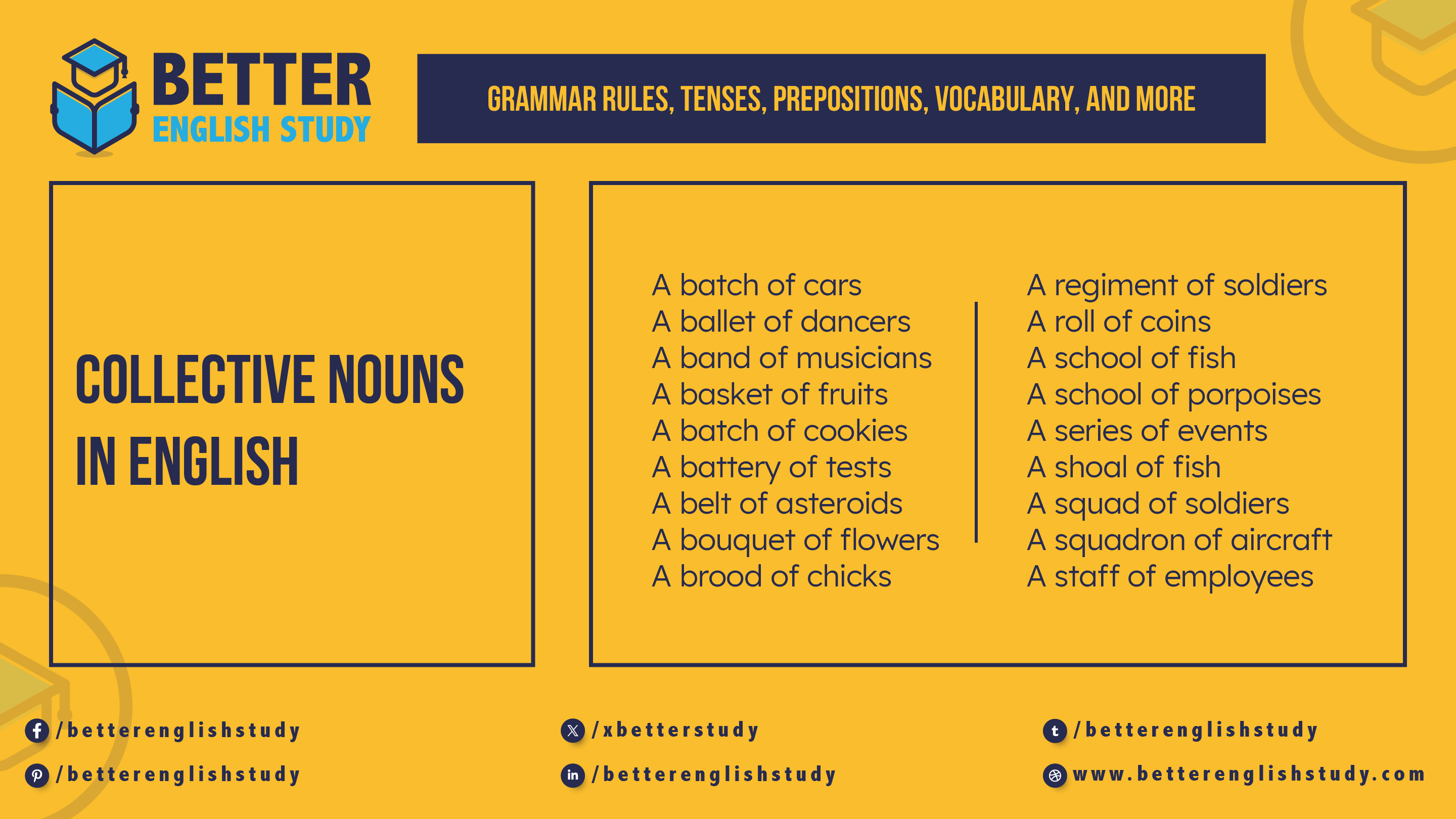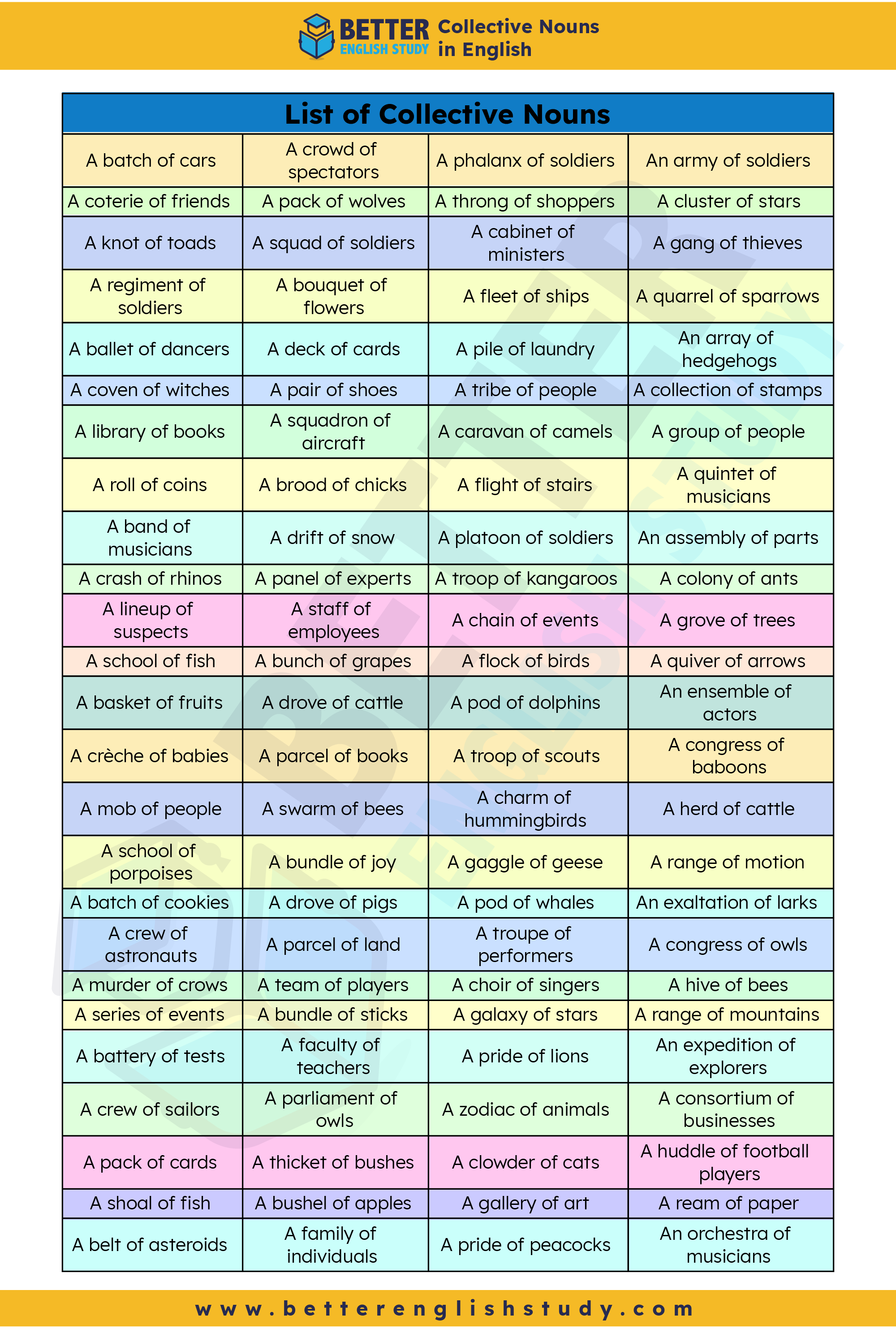
Have you ever marveled at the harmony of a flock of birds, the synchronized movements of a dance troupe, or the shared laughter of a family? These scenarios are beautifully encapsulated by a linguistic phenomenon known as collective nouns.
In this exploration, we’ll unravel the concept of collective nouns, understand what makes them unique, and explore examples that showcase the richness of language when describing groups of people, animals, or things.
Defining Collective Nouns
Collective nouns are words specifically used to denote a group of people, animals, or things. They go beyond individual entities and provide a way to refer to a collection or number of individuals as a single, unified whole. These nouns serve as a linguistic tool to express a group’s togetherness and shared identity.
Identifying Collective Nouns
Imagine a scenario where a group of birds soars through the sky, each wingbeat contributing to the fluidity of their collective movement. We use collective nouns in language to capture this sense of unity and shared identity. Whether it’s a “flock” of birds, a “crowd” of people, or a “choir” of singers, collective nouns bring a sense of cohesion to our expressions.
List of 100 collective nouns
| A batch of cars | A coterie of friends | A knot of toads | A regiment of soldiers |
| A ballet of dancers | A coven of witches | A library of books | A roll of coins |
| A band of musicians | A crash of rhinos | A lineup of suspects | A school of fish |
| A basket of fruits | A crèche of babies | A mob of people | A school of porpoises |
| A batch of cookies | A crew of astronauts | A murder of crows | A series of events |
| A battery of tests | A crew of sailors | A pack of cards | A shoal of fish |
| A belt of asteroids | A crowd of spectators | A pack of wolves | A squad of soldiers |
| A bouquet of flowers | A deck of cards | A pair of shoes | A squadron of aircraft |
| A brood of chicks | A drift of snow | A panel of experts | A staff of employees |
| A bunch of grapes | A drove of cattle | A parcel of books | A swarm of bees |
| A bundle of joy | A drove of pigs | A parcel of land | A team of players |
| A bundle of sticks | A faculty of teachers | A parliament of owls | A thicket of bushes |
| A bushel of apples | A family of individuals | A phalanx of soldiers | A throng of shoppers |
| A cabinet of ministers | A fleet of ships | A pile of laundry | A tribe of people |
| A caravan of camels | A flight of stairs | A platoon of soldiers | A troop of kangaroos |
| A chain of events | A flock of birds | A pod of dolphins | A troop of scouts |
| A charm of hummingbirds | A gaggle of geese | A pod of whales | A troupe of performers |
| A choir of singers | A galaxy of stars | A pride of lions | A zodiac of animals |
| A clowder of cats | A gallery of art | A pride of peacocks | An army of soldiers |
| A cluster of stars | A gang of thieves | A quarrel of sparrows | An array of hedgehogs |
| A collection of stamps | A group of people | A quintet of musicians | An assembly of parts |
| A colony of ants | A grove of trees | A quiver of arrows | An ensemble of actors |
| A congress of baboons | A herd of cattle | A range of motion | An exaltation of larks |
| A congress of owls | A hive of bees | A range of mountains | An expedition of explorers |
| A consortium of businesses | A huddle of football players | A ream of paper | An orchestra of musicians |
Examples of Collective Nouns in a Sentence
Let’s delve into a variety of collective nouns that encompass groups of people, animals, and things:
- Flock: The graceful flock of birds painted patterns across the sky.
“Flock” is a collective noun used for a group of birds flying together, symbolizing unity and coordinated movement.
- Crowd: The lively crowd gathered to celebrate the festival.
“Crowd” is a collective noun representing a gathering of people, capturing the shared excitement and energy of the event.
- Choir: The angelic voices of the choir echoed through the cathedral.
“Choir” is a collective noun for a group of singers harmonizing together during a musical performance.
- Group: The diverse group of animals peacefully grazed in the meadow.
“Group” is a simple yet effective collective noun for gathering animals in a shared space.
- Committee: The dedicated committee of directors worked towards a common goal.
“Committee” is a collective noun used for individuals appointed to make decisions or achieve specific objectives.
- Family: The loving family enjoyed a picnic in the park.
“Family” is a collective noun representing a group of individuals (mother, father, and children) who share a close bond and engage in activities together.
- Team: The determined basketball team practiced tirelessly for the upcoming tournament.
“Team” is a collective noun used for a group of players working together towards a common goal, emphasizing collaboration and unity.
- Agenda: The committee discussed the items on the meeting agenda.
“Agenda” serves as a collective noun for a list of items to be discussed or accomplished during a meeting, reflecting the collective focus of the committee.
- Library: The quiet ambiance of the library welcomed students eager to study.
“Library” is a collective noun for a space where a collection of books is organized and made available to the public, emphasizing the shared resource for learning and research.
- Packet: The diligent students received a packet containing essential information for the science project.
“Packet” is a collective noun used to describe a collection of materials or documents bundled together, emphasizing the organized and cohesive nature of the information.

Singular Yet Collective
Interestingly, collective nouns are singular in form but refer to a collection of individual entities. They act as a single entity when describing the group. For instance, “family” refers to a collection of individuals (mother, father, and children) functioning as a unit. Similarly, a “crew” may consist of numerous sailors working together seamlessly.
Unique Collective Nouns
Certain collective nouns are unique and specific, such as “team” and “government.” These words represent groups with distinct purposes and roles. A “team” collaborates to achieve common objectives, while a “government” governs and administers a nation.
In conclusion, collective nouns are a captivating aspect of the English language that adds depth and precision to our communication. They allow us to describe the unity, coordination vividly, and shared identity of groups, whether they consist of people, animals, or things. So, the next time you witness a group in action, consider the power of collective nouns in encapsulating the beauty of togetherness.
